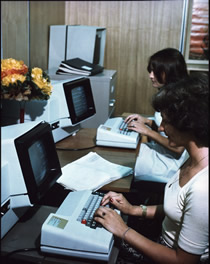
Photocopying service
The photocopying service had been a key part of services since the opening of Robertson Library. At that time, the Australian Copyright Act required the institution providing the copying equipment to keep records about all material copied. Effectively this meant that Library staff, not patrons, did most of the copying, so proper records could be maintained.
The service was at its busiest in 1980 when just over a million pages were copied.
However in 1980, Australian copyright law changed to place legal responsibility on the individual making the copies, rather than on the organisation providing the photocopiers. Staff no longer had to check copies made by clients at the exit from a central copying area. Instead, in 1981, nine self-service photocopiers were placed throughout Robertson Library building and in branch libraries.
With patrons able to do their own copying without checks from Library staff, the number of copies made grew each year, reaching almost 5.3 million in 1989.
The Library as a publisher
Principal Librarian Geoffrey Allen encouraged Library staff to write and publish. Reports on pragmatic in-house research on library goals and practices, student activity in the Library, and the uses made of collections were published, illuminating current practices and enabling improvements. Additionally some staff undertook investigations on a wider front and made a contribution to the corpus of library research in general.16 17
In 1982, Allen launched WAIT Library as a serious, if small scale, publisher in the area of library studies. Previously, the Library’s publishing ventures had been limited to its annual reports, guides to parts of the collection, and a number of bibliographies.
The primary publishing achievement was undoubtedly the production of Western Library Studies, a series of occasional monographs primarily concerned with technical reports on librarianship. It was published from 1983 to 1992 and each of the 16 issues had a distinctive title and subject focus. 18 WAIT/Curtin Library staff were well-represented in many issues.
This venture into publishing had the added benefit of enabling some Library staff to gain skills in editing and book publishing.
Personal computers for staff
As early as 1983, the Library's secretarial and central support service (including the ‘typing pool’) began to use word processing technologies, moving away from typewriters. Staff were trained in the use of a Wang microcomputer (personal computer) and archival workstation. Even earlier, the Library had been the first area in WAIT to buy an IBM Selectric typewriter – with a golf ball type element. These, and other typewriters with limited memory capacity, were the first steps towards personal computers.
By 1986, Library staff had begun to use personal computers for a range of management activities, bringing efficiencies in areas such as budget control, maintenance of personnel records and processing of interlibrary loans.
A unit was also purchased to allow transfer of data from the Wang word processing system to an Apple Macintosh Plus which powered an Apple Laser Writer. These were used in the Library's publication program, significantly reducing the cost of typesetting documents.
Throughout 1989 and 1990, a Local Area Network (LAN) was introduced in stages throughout Robertson Library. The central administration area was first in line with the aging Wang word processing equipment and Appleshare Netware software being replaced by personal computers and the LAN.
As the LAN and new equipment were progressively rolled out, Library staff were able to use Apple Macintosh word processing software for document creation and sharing, activities previously undertaken by the Library's central support services.
 A self-charge machine installed on level two allowed clients to purchase a Library photocopy card and add credit to it.
A self-charge machine installed on level two allowed clients to purchase a Library photocopy card and add credit to it.
 Cover of T L Robertson Library sign manual, by J Henderson, 1982, Perth, WAIT
Cover of T L Robertson Library sign manual, by J Henderson, 1982, Perth, WAIT
This 10 page booklet presenting research commissioned by the Library into the style and presentation of signage was the first commercial publication of WAIT Library. It was well received and made a modest profit.
 Library staff using Wang microcomputers to assist with the word processing and presentation of Library publications, 1983.
Library staff using Wang microcomputers to assist with the word processing and presentation of Library publications, 1983.
With the introduction of the Mac email system, QuickMail, staff were able to communicate more easily and efficiently with others in the Library. Eventually the Library extended the reach of its email communication by linking into the campus Ethernet, then to the University’s mainframe computer and into the Australian Academic and Research Network (AARNET).